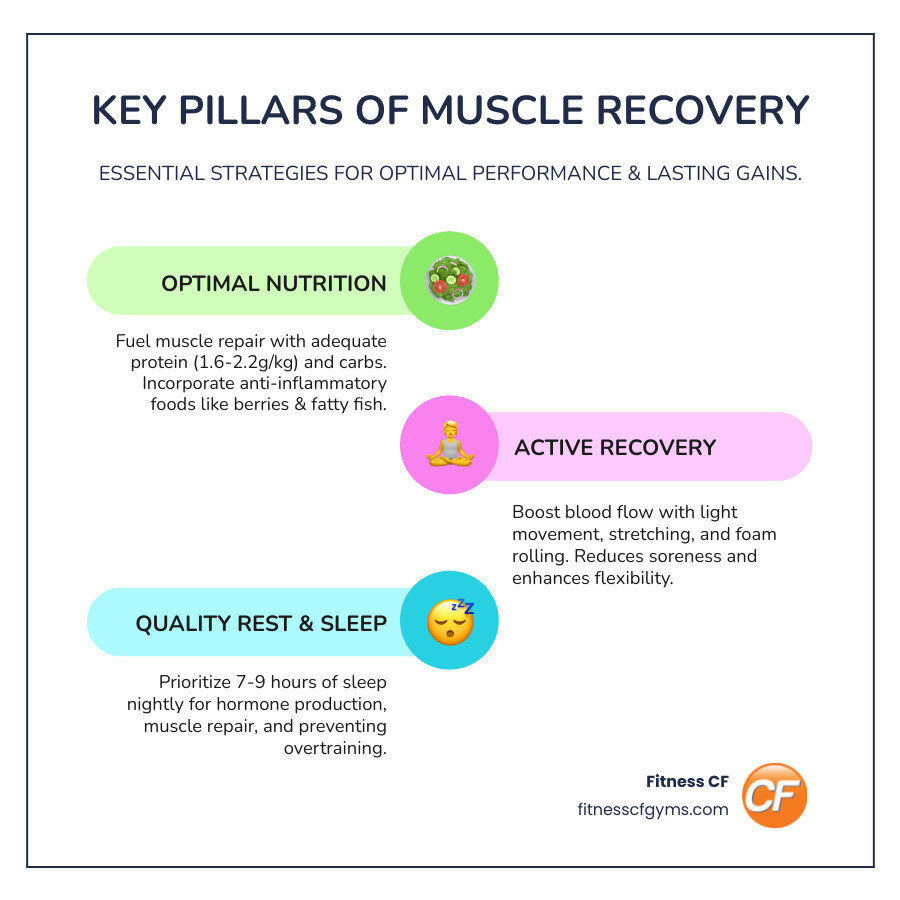Unlock Your Gains: The Best Strategies for Muscle Recovery

Why Muscle Recovery Is the Secret to Your Fitness Success
Good things for muscle recovery are essential for anyone serious about their fitness goals. Whether you’re dealing with post-workout soreness or looking to maximize your training results, the right recovery strategies can make all the difference.
The best things for muscle recovery include:
- Proper nutrition – Protein (1.6-2.2g per kg body weight) and carbohydrates within 60-90 minutes post-workout
- Quality sleep – 7-9 hours nightly for hormone production and muscle repair
- Active recovery – Light movement, stretching, and foam rolling to improve blood flow
- Hydration – Adequate water intake plus electrolyte replacement after intense sessions
- Anti-inflammatory foods – Tart cherry juice, fatty fish, berries, and leafy greens
- Temperature therapy – Cold therapy for pain relief, heat therapy for muscle relaxation
- Rest days – 48-72 hours between intense workouts targeting the same muscle groups
Waking up stiff and sore after a tough workout is known as delayed onset muscle soreness (DOMS). This occurs when intense exercise creates tiny tears in muscle fibers, leading to inflammation as your body repairs and strengthens the tissue.
The good news is that this soreness is a sign your muscles are adapting and getting stronger. Research shows that proper recovery techniques can reduce strength loss from 24% to just 4%. Supporting your body through this process is key to consistent progress, reduced injury risk, and better fitness results.
I’m Pleasant Lewis, and with over 40 years in the fitness industry, I’ve seen these strategies transform workout results and overall quality of life for busy individuals. The methods I’ll share have helped countless members achieve their goals while staying injury-free and energized.

Understanding Muscle Soreness: The Science of Gains
That familiar ache after a new workout isn’t a complaint—it’s progress. When you challenge your muscles with intense exercise, tiny tears form in your muscle fibers. While this sounds alarming, it’s the foundation of getting stronger.
In response, inflammation kicks in as part of the natural repair process, sending immune cells and nutrients to the affected areas. This controlled inflammation is your body’s way of cleaning house and preparing for upgrades.
This triggers muscle protein synthesis, where your body builds new, stronger muscle tissue to replace what was broken down. Over time, this leads to hypertrophy—your muscles getting bigger and more powerful. The soreness you feel is a sign that your muscles are adapting and growing stronger.
Many people don’t realize that cardio plays a crucial role in this recovery process. Cardiovascular exercise improves circulation, meaning more oxygen and nutrients reach your recovering muscles while waste products are swept away more efficiently.
Why soreness is actually a sign of adaptation becomes clear when you understand this process. Your body is literally rebuilding itself to be better prepared for the next challenge. It’s like upgrading your home’s foundation—there might be some disruption, but the end result is a stronger structure.
The science behind the process of muscle repair and remodeling shows how incredible our bodies are at self-improvement. While some muscle soreness is normal, it’s important to know the difference between good things for muscle recovery and signs of injury. Understanding How to Prevent and Recover from Common Workout Injuries can help you stay on the right side of that line.
The next time you feel that post-workout soreness, smile. Your body is hard at work making you stronger.
The Ultimate Nutrition Plan for Muscle Repair

What you eat post-workout is as crucial as the exercise itself. Your meal is the fuel for rebuilding stronger muscles, providing the exact nutrients needed for repair and growth. The good things for muscle recovery begin with a mix of macronutrients (protein, carbs, fats) and micronutrients (vitamins, minerals) to create the ideal healing environment. This foundation supports your immediate recovery and long-term fitness.
The Role of Protein and Carbs: Good Things for Muscle Recovery
The first 60-90 minutes post-exercise, the “anabolic window,” is when your body is most efficient at starting muscle repair, though recovery continues for 12-24 hours.
Protein provides amino acids, the building blocks for repairing muscle tears and building new tissue. Aim for 1.6 to 2.2 grams of protein per kilogram of body weight daily for effective recovery.
Carbohydrates restore your muscles’ glycogen stores, their primary fuel. Eating carbs post-workout refuels you for your next session.
Protein and carbs work best together. Carbs trigger an insulin response that helps shuttle amino acids into your muscle cells, a combination proven to improve glycogen replenishment more effectively than carbs alone.
For a complete guide on timing your nutrition around workouts, check out The Role of Nutrition in Fitness: What to Eat Before and After a Workout.
5 Quick & Effective Post-Workout Snack Ideas
Here are five good things for muscle recovery that are both delicious and effective:
- Greek yogurt with berries – Protein-packed yogurt pairs with antioxidant-rich berries.
- Chocolate milk – An ideal balance of protein, carbs, and electrolytes, as effective as many sports drinks.
- Turkey sandwich on whole-grain bread – Lean protein and sustained-energy whole grains.
- Smoothie with protein powder and banana – A quick, customizable, potassium-rich recovery drink.
- Oatmeal with nuts and fruit – A mix of complex carbs, healthy fats, and vitamins.
For more ideas, explore What to Eat After a Workout.
Anti-Inflammatory Foods and Hydration
Fighting inflammation is also key. Intense exercise creates free radicals, but the right foods can neutralize them. Antioxidants are important as they act as your body’s cleanup crew.
- Berries: Antioxidant powerhouses that help you bounce back.
- Fatty fish: Salmon and mackerel provide omega-3s to reduce inflammation and ease soreness.
- Leafy greens: Spinach and kale are packed with vitamins, minerals, and antioxidants.
- Tart cherry juice: Research shows it can lessen muscle pain and speed recovery.
Hydration is also vital. Dehydration hinders nutrient transport and waste removal, prolonging soreness. Aim for 8 ounces of water for every 15-30 minutes of exercise, plus 8 ounces for every pound of body weight lost. After intense sessions, consider natural electrolyte sources like coconut water.
Foods and Supplements to Approach with Caution
Some foods can hinder recovery. Added sugars, alcohol, and highly processed foods can increase inflammation and interfere with muscle-building processes.
In the supplement world, a few have solid research. Creatine is well-studied for improving muscle strength and recovery, as research shows it helps maintain energy for muscle repair. Branched-Chain Amino Acids (BCAAs) are involved in muscle protein synthesis but may not be necessary if your protein intake is sufficient.
Since the FDA doesn’t strictly regulate supplements, consult a doctor or registered dietitian before adding them to your routine to ensure they are safe and appropriate for you.
Active vs. Passive: Good Things for Muscle Recovery in Practice

After a tough workout, your body craves gentle movement, not more intensity. This is active recovery, one of the most powerful good things for muscle recovery. Active recovery improves blood flow, which carries away metabolic waste and delivers oxygen and nutrients to help your muscles heal.
The Power of Active Recovery and Stretching
Active recovery involves gentle, purposeful movement that keeps your body in motion without adding stress.
- Light walking, gentle yoga, and easy cycling are excellent options that promote circulation and reduce stiffness.
- A proper cool-down of 10-15 minutes is your first defense against soreness, helping your body transition smoothly back to a resting state.
A 2018 literature review found that active recovery significantly reduces delayed-onset muscle soreness compared to passive rest.
Stretching is also a key tool. Static stretching (holding a stretch for 30 seconds) when muscles are warm improves flexibility. Dynamic stretching (flowing movements) is ideal for warm-ups.
For comprehensive guidance, explore The Importance of Warm-up and Cool-down Exercises: A Comprehensive Guide. Athletes can dive deeper with Active Recovery for Athletes.
Massage and Foam Rolling for Soreness Relief
Self-myofascial release via massage and foam rolling applies targeted pressure to release tension in muscles and fascia (the connective tissue web).
- Foam rolling helps break up muscle adhesions (knots) that limit flexibility. Just 10-15 minutes post-workout can improve blood flow and release tension.
- Massage guns use percussive therapy, delivering rapid pulses to alleviate soreness and boost circulation.
A meta-analysis found massage to be the most effective method for reducing DOMS and fatigue. While professional massage is great, foam rollers and massage tools offer convenient at-home relief. These techniques actively improve your range of motion and prevent stiffness. To expand your flexibility toolkit, check out Stretching Routines to Improve Flexibility and Prevent Injuries.
Cold vs. Heat Therapy for Muscle Recovery
The timing of ice versus heat can make a significant difference.
| Therapy Type | Best For Immediate Recovery (0-24 hrs) | Best For Later Recovery (24-48 hrs) | Primary Mechanism |
|---|---|---|---|
| Cold Therapy (Ice Baths, Cold Showers) | Pain reduction, reducing inflammation | Reducing muscle damage, strength recovery | Vasoconstriction (narrows blood vessels) |
| Heat Therapy (Heating Pads, Hot Baths) | Strength recovery, preventing tissue damage | Relaxation, increasing blood flow | Vasodilation (widens blood vessels) |
Cold therapy narrows blood vessels to numb pain and minimize swelling. Heat therapy widens blood vessels to increase blood flow, bringing healing nutrients and promoting relaxation.
Research shows that people using either hot or cold therapy experienced only 4% strength loss, compared to 24% loss in those using no therapy. This proves that doing something is far better than nothing. Contrast therapy (alternating hot and cold) may improve circulation even more effectively. The key is to listen to what your body responds to best.
The Foundation of Fitness: Sleep, Rest, and Avoiding Overtraining

Imagine amplifying all your workout and nutrition efforts while you do nothing. That’s the power of quality sleep and rest—truly the most underrated good things for muscle recovery. Without adequate rest, our bodies can’t perform the deep cellular repair needed for muscle growth, affecting everything from Human Growth Hormone (HGH) production to cortisol levels, mental health, and consistency.
Why Sleep is Your Ultimate Recovery Tool
When you sleep, your body shifts into repair mode. During deep sleep, your body releases most of its growth hormone, which is essential for tissue repair and muscle protein synthesis. The magic number for most adults is 7-9 hours of quality sleep per night. Quality is as important as quantity; seven hours of deep sleep is better than nine hours of tossing and turning.
Sleep quality and duration both matter, but so does consistency. A regular sleep schedule regulates your body’s internal clock. Research confirms that sleep deprivation impairs muscle recovery by affecting inflammation and hormone production. You wouldn’t skip meals and expect to build muscle, so don’t skip sleep and expect to recover.
Overtraining, Rest Days, and Stress Management
It’s easy to fall into the “more is better” trap, but muscles grow during recovery, not the workout. Overtraining occurs when you push beyond your body’s ability to recover. Signs of overtraining include persistent soreness, declining performance, chronic fatigue, mood changes, and frequent illness or injury. If these sound familiar, prioritize recovery.
Rest days aren’t lazy; they’re productive. Your body uses this time to repair tissue and replenish energy. Aim for one to two rest days per week. It’s crucial to listen to your body and learn the difference between needing a push and needing a break.
Chronic stress is another recovery killer. High levels of the stress hormone cortisol can interfere with muscle repair. Mindfulness techniques like deep breathing, meditation, or a warm bath can lower cortisol and improve recovery. Understanding the physiological symptoms of overtraining helps you recognize when rest is necessary. Fitness is a marathon, and balancing challenge with recovery is key to long-term, sustainable health.
Frequently Asked Questions about Muscle Recovery
Understanding the difference between normal recovery and potential problems is one of the most important good things for muscle recovery knowledge you can have.
How long does it take for muscles to recover?
Recovery time depends on workout intensity, fitness level, age, nutrition, and sleep.
- Light exercise: Recovery within 24 hours.
- Challenging strength/cardio: Full recovery in 24-72 hours.
- Very strenuous exercise: May require up to a week.
The recovery process begins immediately, with muscles being most receptive to nutrients in the first 60-90 minutes post-workout. Muscle protein synthesis peaks over the next 12-24 hours. The most important rule is to listen to your body. If you’re still significantly sore or fatigued, take another rest day to come back stronger.
What’s the difference between muscle soreness and an injury?
This distinction can save you from setbacks. DOMS (delayed onset muscle soreness) is a sign of adaptation.
- DOMS: Feels dull, achy, and widespread. It appears 12-48 hours post-workout, is often symmetrical, and improves with light movement.
- Injury Pain: Often sharp, localized, and may have appeared suddenly. It typically gets worse with movement and may involve swelling or bruising.
Think of DOMS as your muscles saying “that was challenging!” while injury pain is your body shouting “stop!”
When should I see a doctor for muscle soreness?
While some soreness is normal, see a professional if you experience any of the following:
- Pain lasting more than 72 hours without improvement.
- Severe swelling or discoloration.
- Inability to move a limb through its normal range of motion.
- Signs of infection like unusual redness, warmth, or discharge.
Getting checked out is always the smart choice for your long-term fitness journey.
Conclusion
Fitness success isn’t just about workout intensity; the real magic happens during recovery. Good things for muscle recovery are the foundation of any effective training plan. Without proper recovery, you’ll eventually hit a wall, as your muscles, nervous system, and mind need time to repair and reset.
The beauty of recovery is its simplicity:
- Eat a balanced meal with protein and carbs within 60-90 minutes post-workout.
- Get 7-9 hours of quality sleep for deep repair.
- Take active recovery days with gentle movement like walking or stretching.
These fundamental practices support your fitness goals and overall well-being, leading to long-term health benefits like better sleep, reduced stress, and a more resilient body. Creating a sustainable fitness routine means recognizing that rest isn’t the opposite of progress—it’s an essential part of it. Training hard and recovering smart will always lead to better results than simply training hard.
At Fitness CF, we believe a healthy lifestyle is built on effective workouts and even smarter recovery. We understand that our members juggle busy schedules, family responsibilities, and the desire to feel their best. That’s why we’re committed to supporting not just your training, but your entire wellness journey.
Ready to experience how proper recovery can transform your fitness results? Start your fitness journey with us today and find what it feels like when your body has everything it needs to thrive.





